Physical Address
304 North Cardinal St.
Dorchester Center, MA 02124
Physical Address
304 North Cardinal St.
Dorchester Center, MA 02124
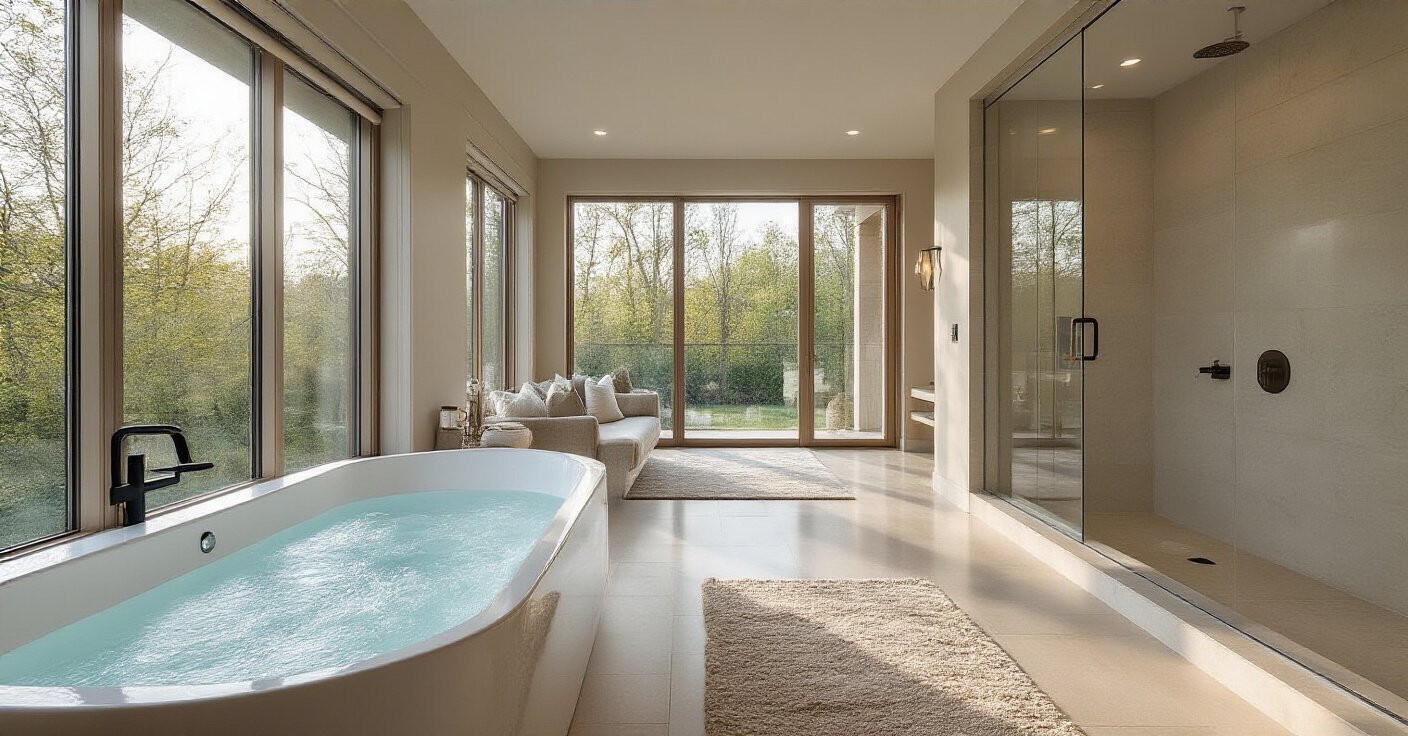
Discover 22 luxury bathroom ideas that build harmony. Designer tips for multi-generational homes that value comfort, culture, and connection for the whole family.
I used to think a “luxury bathroom” just meant coating everything in expensive marble and gold. That was before I started designing homes for real, complex, multi-generational families. Then I watched a client—a wonderful woman caring for her mother with dementia and her two teenage sons—nearly break down in tears over a glossy magazine photo of a bathroom. It was beautiful, but it was also useless for her. The slick floors, the tub you had to climb into, the pedestal sink with zero storage… it was a space designed for one person, not a family.
That’s when it clicked. True luxury isn’t about impressing guests. It’s about creating a sense of peace, dignity, and harmony for the people who live there every single day. It’s a space that works for the granddaughter who needs a step-stool, the teenager who needs their own zone, and the grandfather who needs a safe place to sit. It’s about thoughtfully designing a room that bridges cultural differences and diverse abilities, making sure everyone feels seen, respected, and comfortable.
So let’s talk about what actually makes a bathroom feel luxurious. It’s not about the price tag. It’s about how it serves your family.
Everything starts with the bones of the room. Before you pick a single tile or faucet, the layout has to be right. This is where you create the flow and foundation that makes a space feel generous and easy to navigate for everyone, regardless of age or ability.
Okay, let’s address the big trend. Everyone says an open concept bathroom, flowing into the bedroom, is the height of luxury. And for some couples in a private home, maybe. But for most of the families I work with—especially those from cultures where modesty and privacy are paramount—it’s a complete non-starter. You can’t have Grandpa walking through your open-plan bathroom to get to his room.
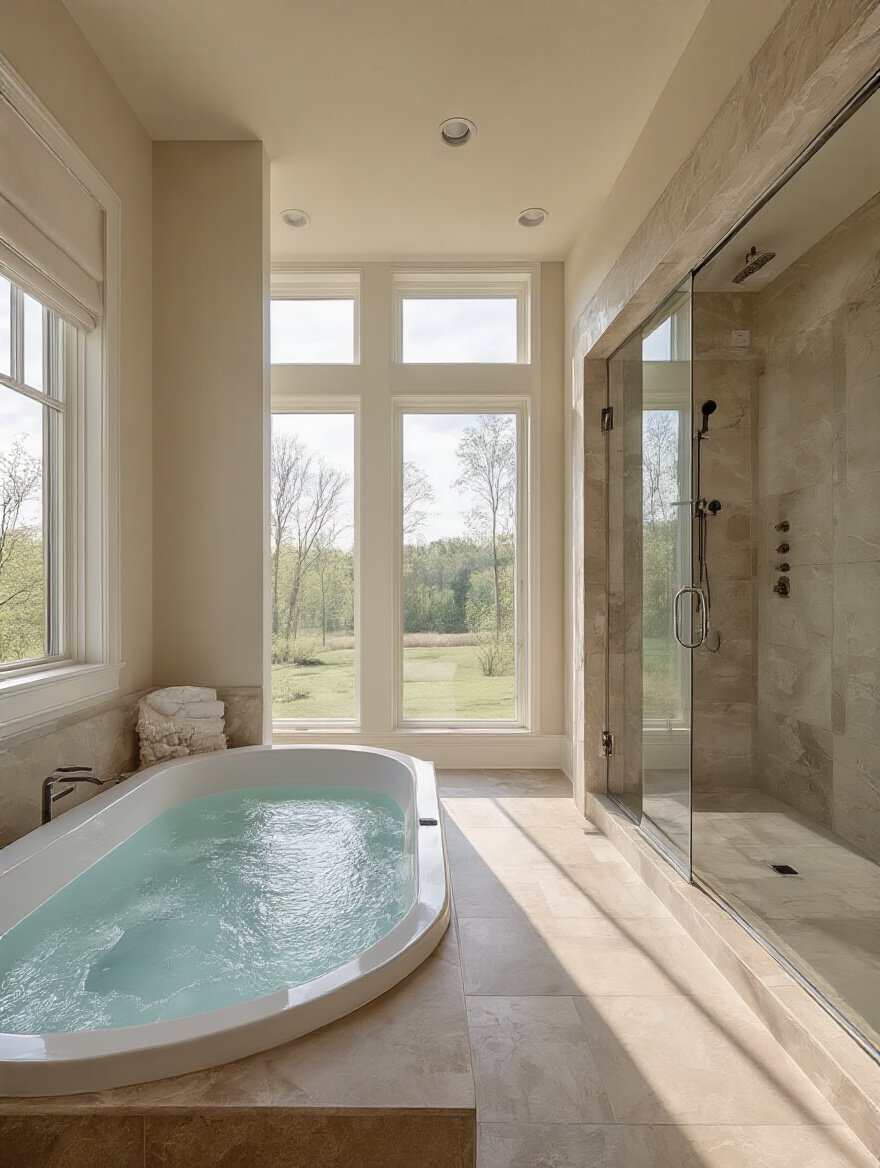
So let’s redefine this. The real goal isn’t to have no walls; it’s to create a feeling of spaciousness and light. You can achieve this with large doorways, pocket doors that disappear when not in use, or even beautiful Shoji-style screens that create separation without feeling heavy. The idea is to design clear, distinct zones—a wet zone for bathing, a dry zone for the vanity, and a private zone for the toilet—that flow together logically without sacrificing dignity and privacy.
From creating a sense of openness, the next logical step is to fill that space with the one thing that makes any room feel better: natural light.
Bringing in daylight is about so much more than a pretty view; it’s about well-being. Natural light helps regulate our circadian rhythms, which is incredibly important for older adults and young children. It boosts mood and makes a space feel cleaner and more expansive. I once had a client whose elderly father was experiencing sundowning in the evenings. We installed a large skylight in his bathroom, and the increased daylight exposure made a noticeable difference in his mood and sleep patterns.
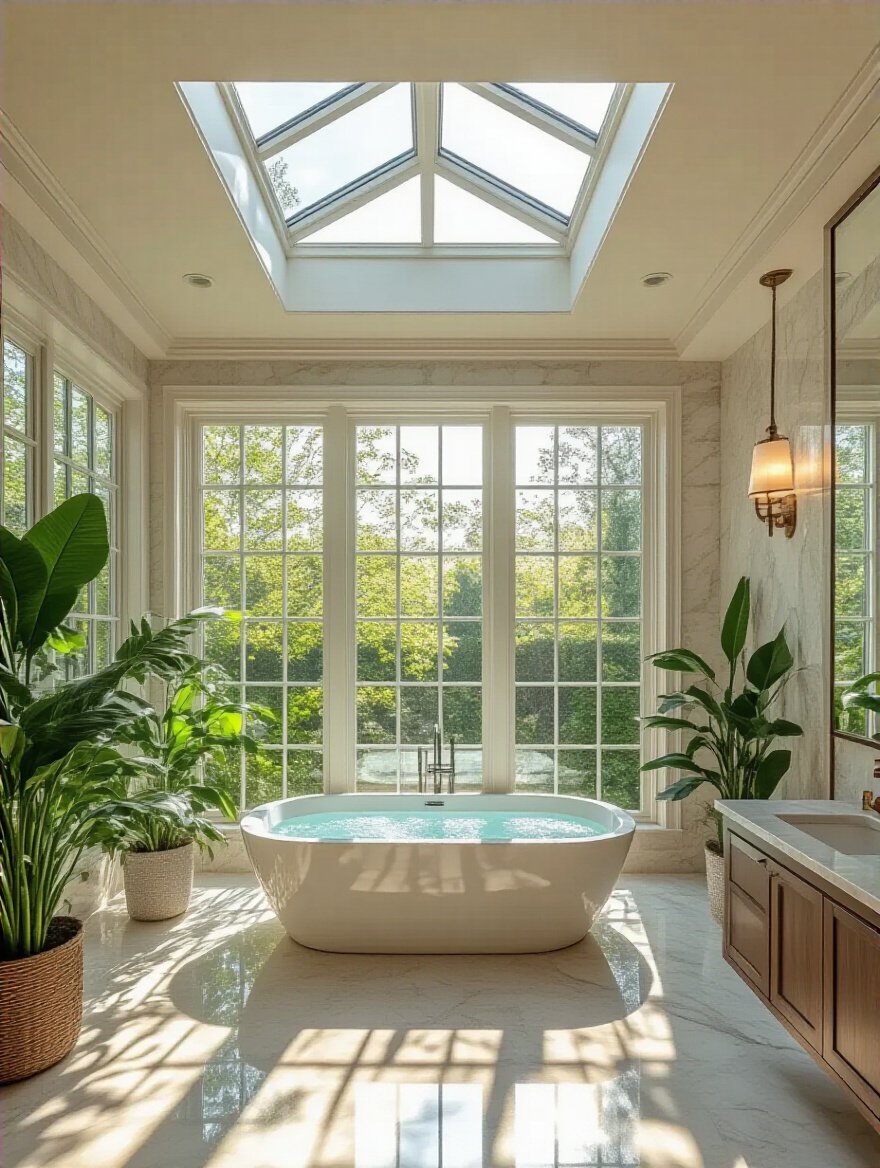
But of course, with light comes the issue of privacy. The solution isn’t to give up on windows. It’s to be smart about them. Clerestory windows—those high, short windows placed near the ceiling—are a brilliant solution. They flood the room with light without giving anyone a direct line of sight. Frosted or reeded glass offers beautiful, diffused light while maintaining total privacy. And for the ultimate control, smart glass can switch from clear to opaque with the flick of a a switch.
Now that the room is bright, let’s make it feel warm and comfortable from the ground up.
This is one of my non-negotiables for a truly comfortable family bathroom. Can we talk about how jarring it is to step out of a warm shower onto an ice-cold tile floor? Underfloor radiant heating is the silent, invisible hero of bathroom comfort. It provides a gentle, consistent warmth that feels incredible underfoot and warms the whole room more evenly than forced-air vents.
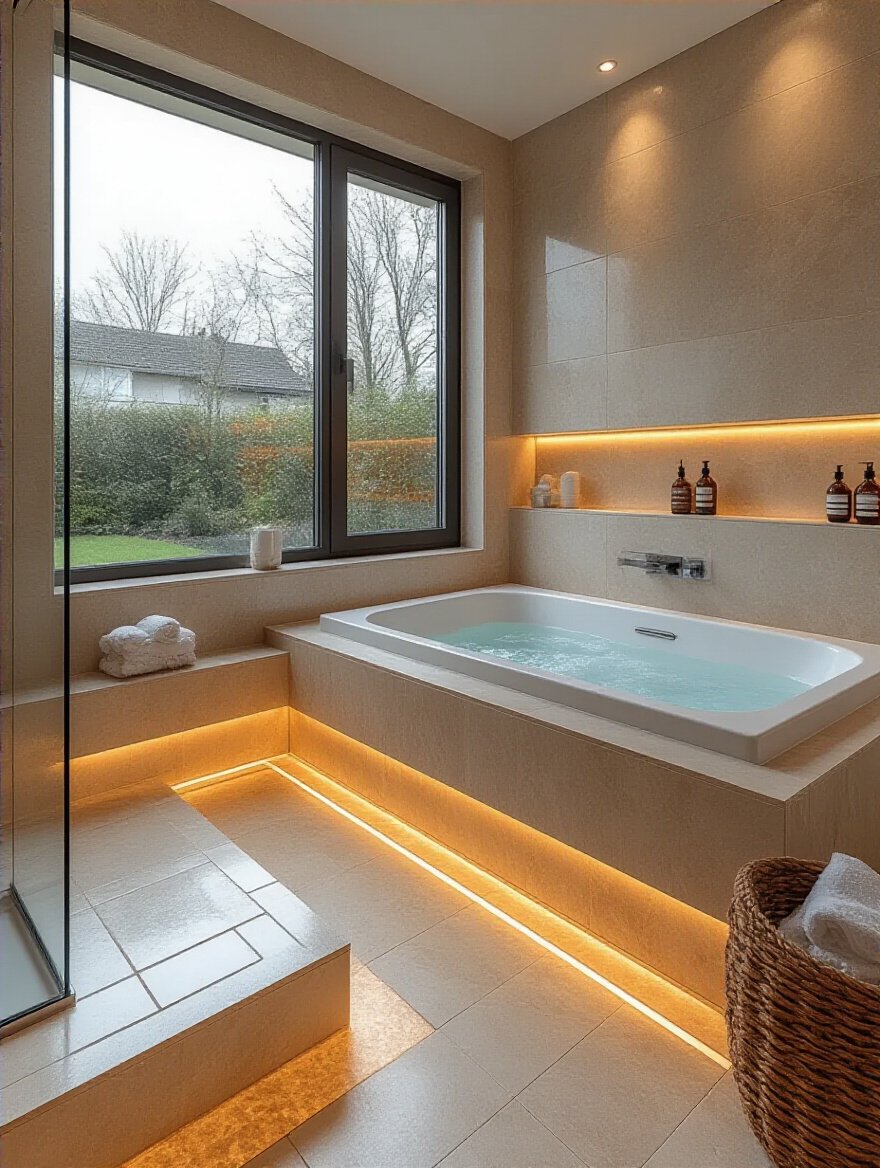
For a family, this isn’t just a luxury; it’s a safety feature. It eliminates the need for space heaters, and there are no hot radiators for a toddler to touch or an older person to bump into. I designed a bathroom for a family where the grandmother was diabetic and had chronically cold feet. Zoned heating meant she could have the floor in her vanity area a little warmer, which she said completely changed her morning routine for the better. It’s that kind of thoughtful detail that elevates a room.
Building on that foundation of warmth and comfort, let’s create a showering space that’s both beautiful and universally accessible.
The walk-in, zero-threshold wet room is the single most important design choice you can make for a multi-generational home. People see it as a sleek, modern look, but what it really is, is future-proofing. It’s designing for life. A flat, seamless floor with no curb to step over means it’s easily accessible for a person in a wheelchair, someone using a walker, or just a child who might trip. It’s also incredibly easy to clean.
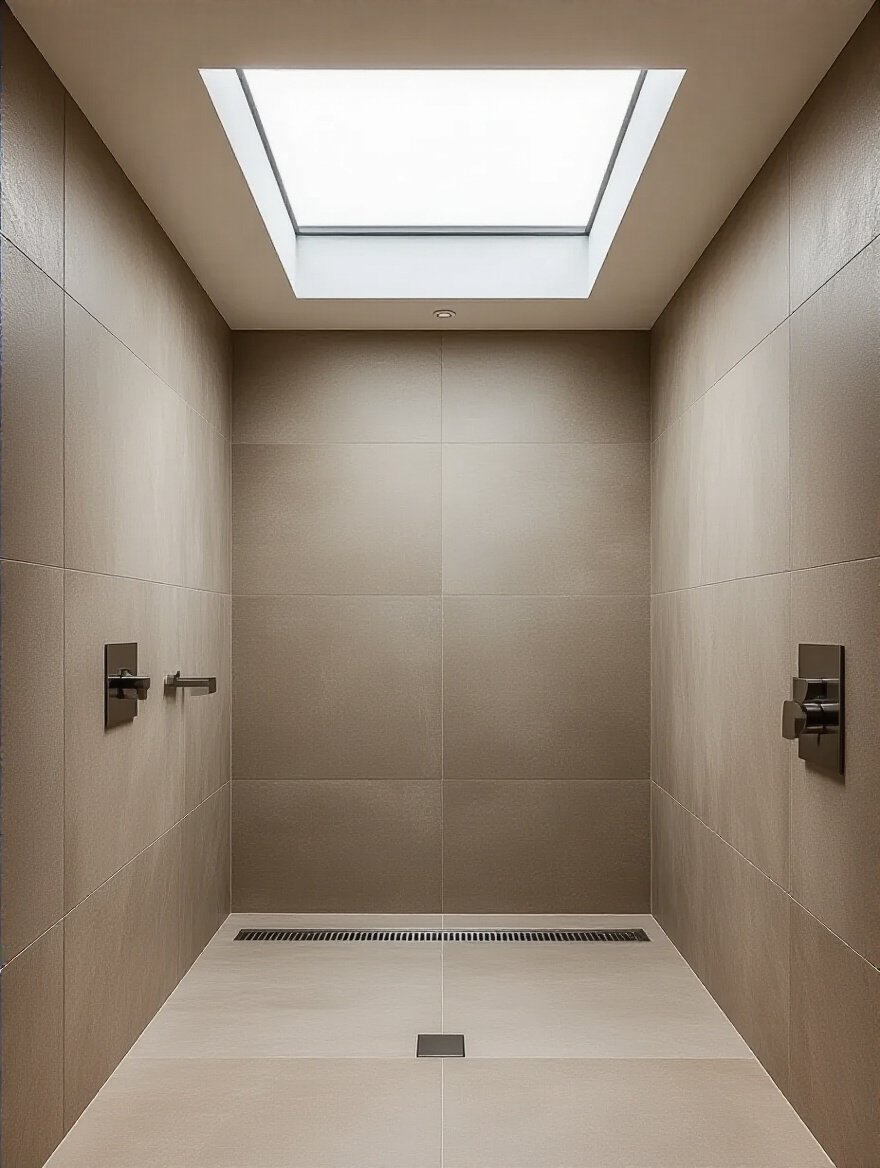
I had a client in his 50s who was skeptical—he thought it looked a bit sterile. A year after the renovation, he called to thank me. His father had a fall and needed to use a shower chair for a few months during recovery. Because they had designed a wet room, his dad could maintain his independence and dignity without a hugely expensive or disruptive second renovation. That’s the real power of good design. It anticipates life’s changes.
With a beautiful open space, the next step is to carve out personal areas within it for daily rituals.
In a busy household, the bathroom can be a point of conflict. Creating a dedicated sit-down vanity area is one of the best shortcuts to family harmony I know. It moves the slower rituals—applying makeup, drying hair, organizing medications—away from the main sink, freeing it up for others. It gives a teenager her own space to spread out, and more importantly, it gives an older family member a safe, stable place to sit while they get ready.
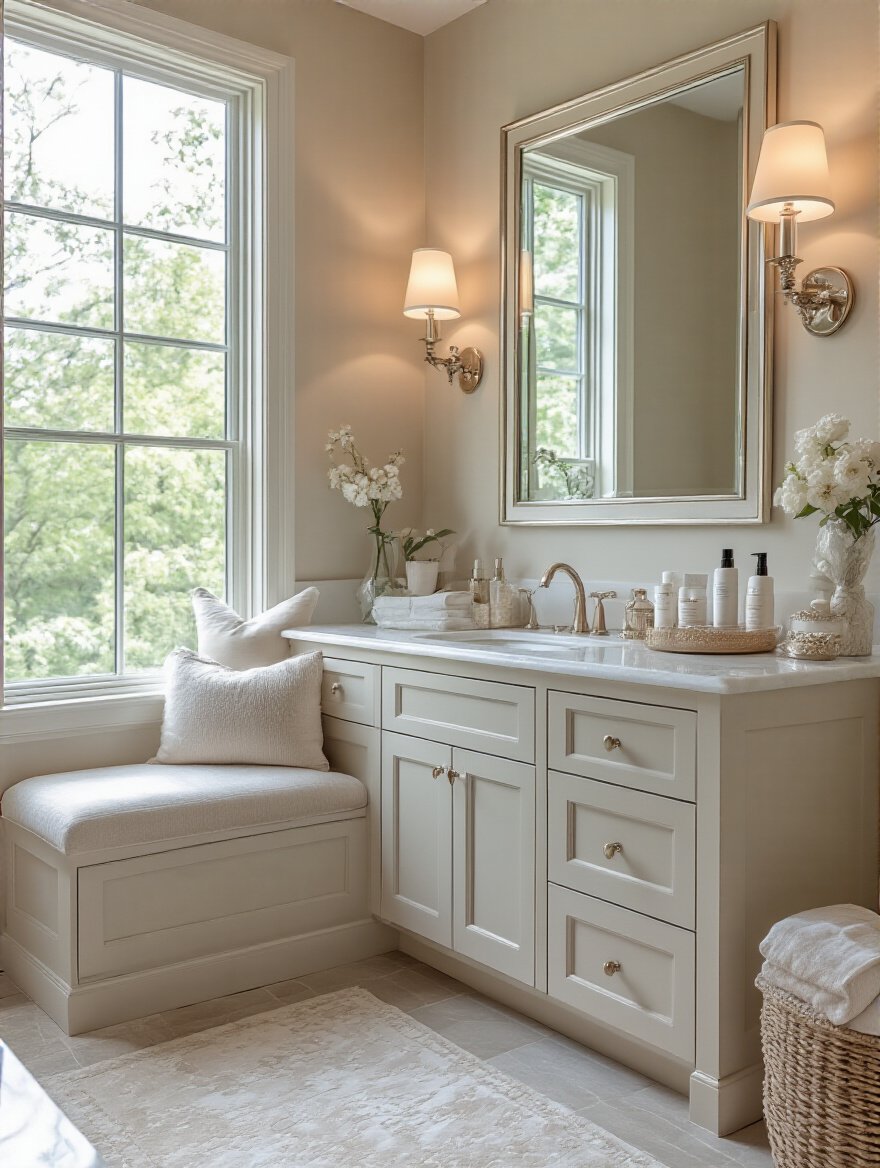
I’ve learned this the hard way. Early in my career, I designed a stunning, minimalist bathroom with just one sink to “save space.” The family, who had two daughters, called me two months later to ask if I could add a second vanity. The morning arguments were constant. Now, I always plan for a spot with a comfortable, moisture-resistant stool or bench. It’s a simple addition that shows respect for each person’s private routine and personal space.
Once the layout serves everyone, you can start choosing the pieces that bring beauty and personality to the space. This isn’t about brand names. It’s about selecting fixtures that are durable, easy to use for all abilities, and feel good to the touch.
Freestanding tubs are beautiful, like sculpture for the bathroom. They can be a stunning centerpiece. But—and this is a big but—they are not always the most practical choice for a family. Cleaning behind and under them can be a real pain, and they often lack a wide deck for shampoo, soap, or for a parent to sit on while bathing a child. For someone with mobility issues, getting in and out can be a challenge.
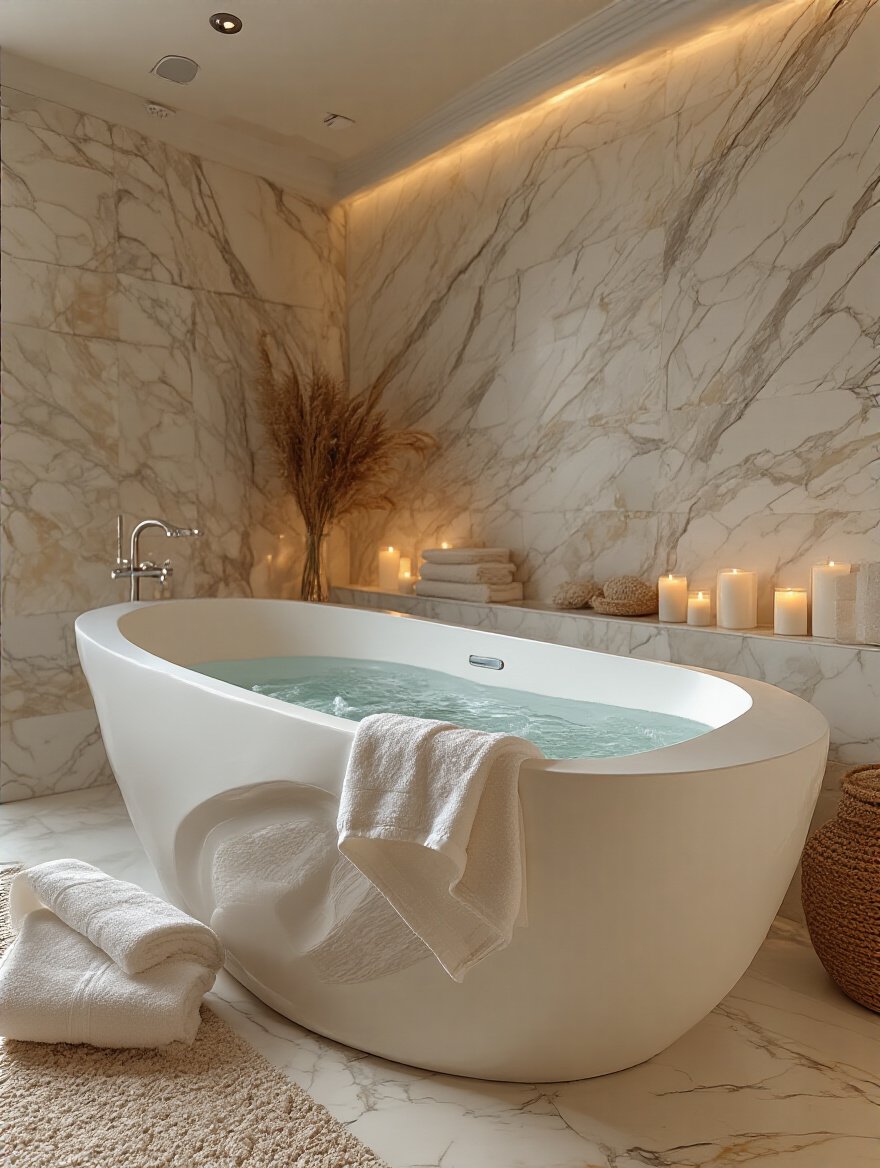
So, if you love the look, go for it! But be honest about how you live. A beautifully designed built-in tub with a wide, comfortable deck can be just as luxurious and a lot more functional. I once worked with a family who chose a deep, built-in Japanese-style soaking tub (an ofuro) with wide wooden decking around it. It became the heart of the room, a place for peaceful soaking that was also easy and safe for everyone to access.
Moving from serene soaks, let’s talk about a showering experience that caters to everyone’s preferences.
Here’s where technology can be a huge asset for family living. A smart shower isn’t a gimmick; it’s a tool for personalization and safety. Most systems allow you to create profiles for each family member. So, your father-in-law who prefers a lower temperature and a gentler spray can have his setting saved. Your husband who likes a blasting-hot, high-pressure shower can have his.
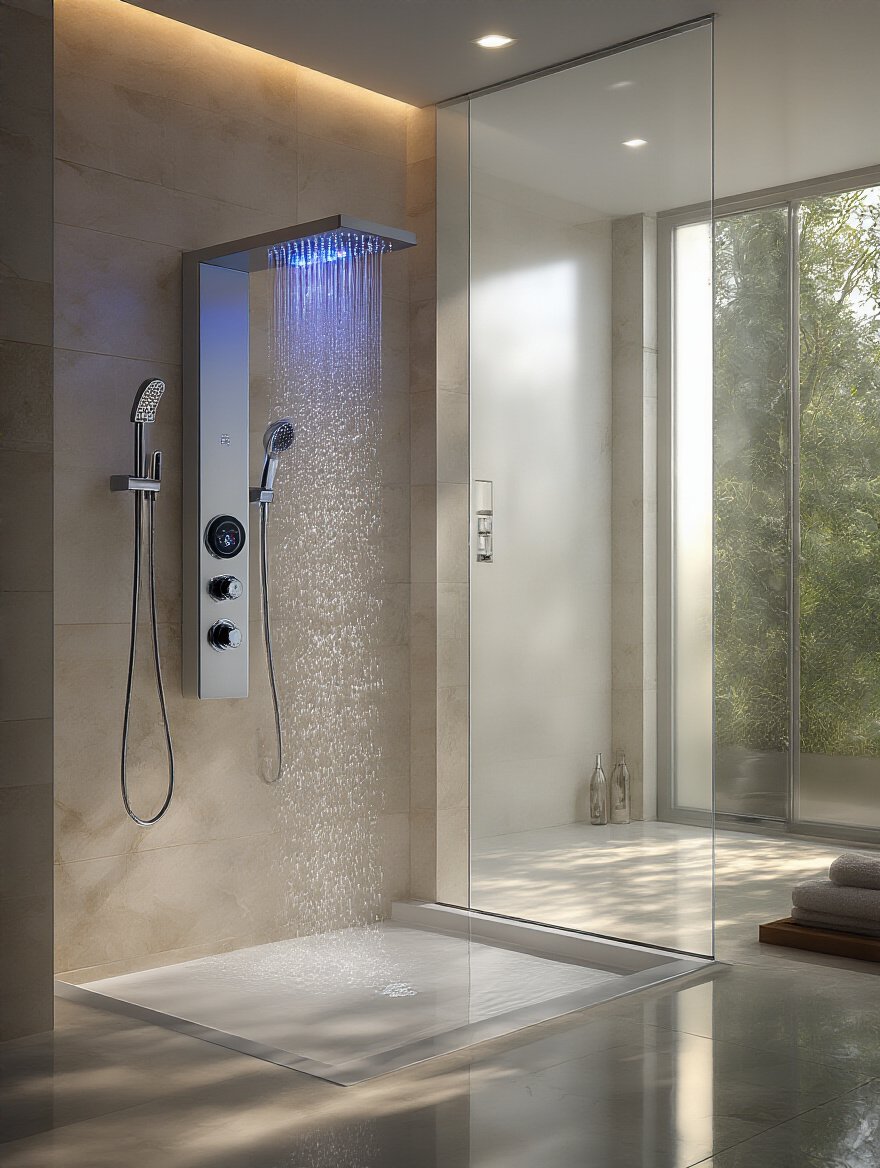
This is a game-changer for safety. You can set a maximum temperature to prevent scalding, which is critical in a home with small children or older adults. A client of mine with an autistic son found this feature invaluable. Her son was sensitive to sudden changes in temperature, and the pre-set, consistent shower profile made bathing a calm, predictable experience for him instead of a source of anxiety.
Next to the shower, the vanity is the most-used spot in the bathroom. Let’s make it work for everyone.
Dual vanities are a classic for a reason: they are peacemakers. Giving two people their own sink and counter space immediately reduces morning chaos. But “bespoke” is the key word here. Custom design means you can solve real-world family problems. You can make one vanity counter slightly lower for a family member in a wheelchair, or for the kids.
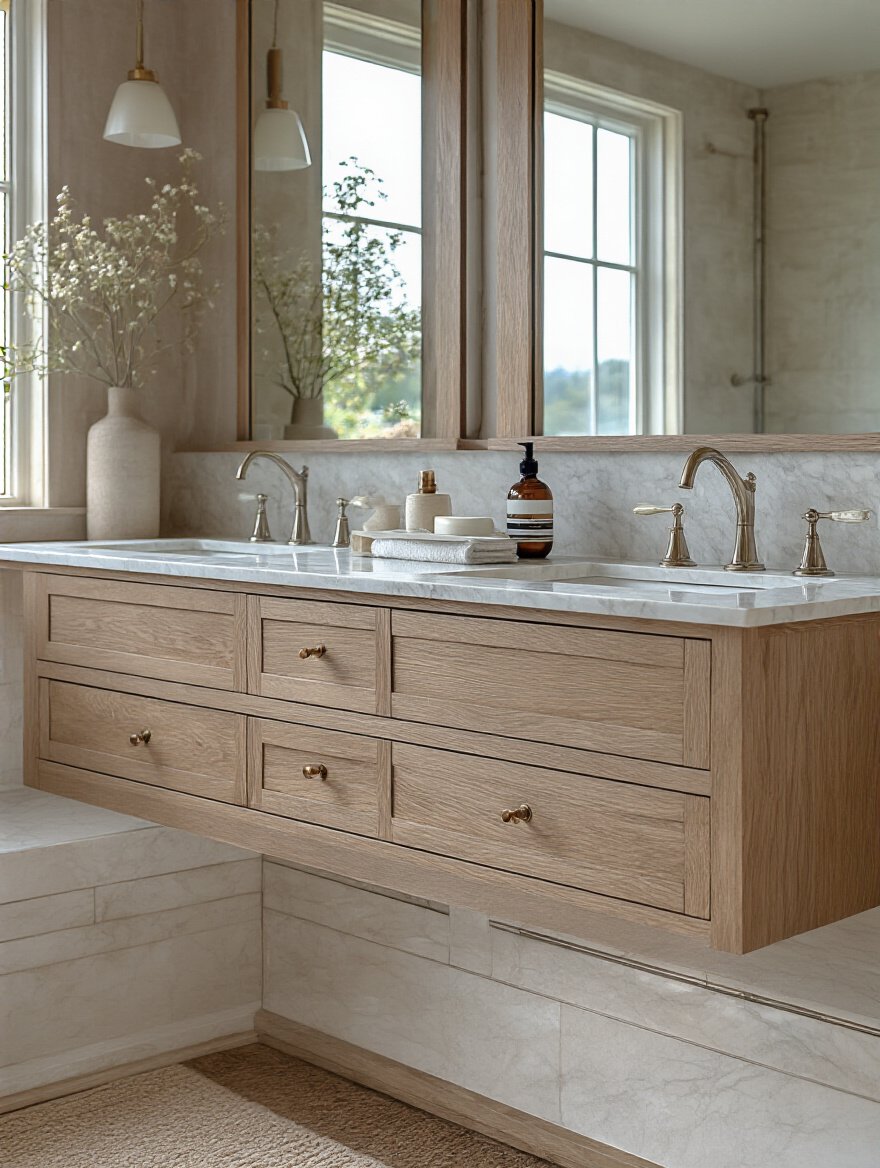
One of my favorite solutions was for a family from India. The grandmother preferred to have a separate faucet at a lower level for ritual washing, separate from the main sink. We designed a long, beautiful stone vanity with two vessel sinks up top and a discreet, wall-mounted spigot and a small floor drain below on one side. It was a simple, elegant solution that respected her cultural practices and made her feel truly at home. That’s the difference custom design makes.
The fixtures you choose for those vanities matter just as much as the vanities themselves.
This might sound like a purely aesthetic choice, but it’s one of my favorite practical tricks. Wall-mounted faucets look clean and modern, but the real benefit is how incredibly easy they make cleaning the countertop. There’s no faucet base to collect gunk and hard water stains. You just wipe the counter clean. In a busy family bathroom, that small-time-saver adds up.
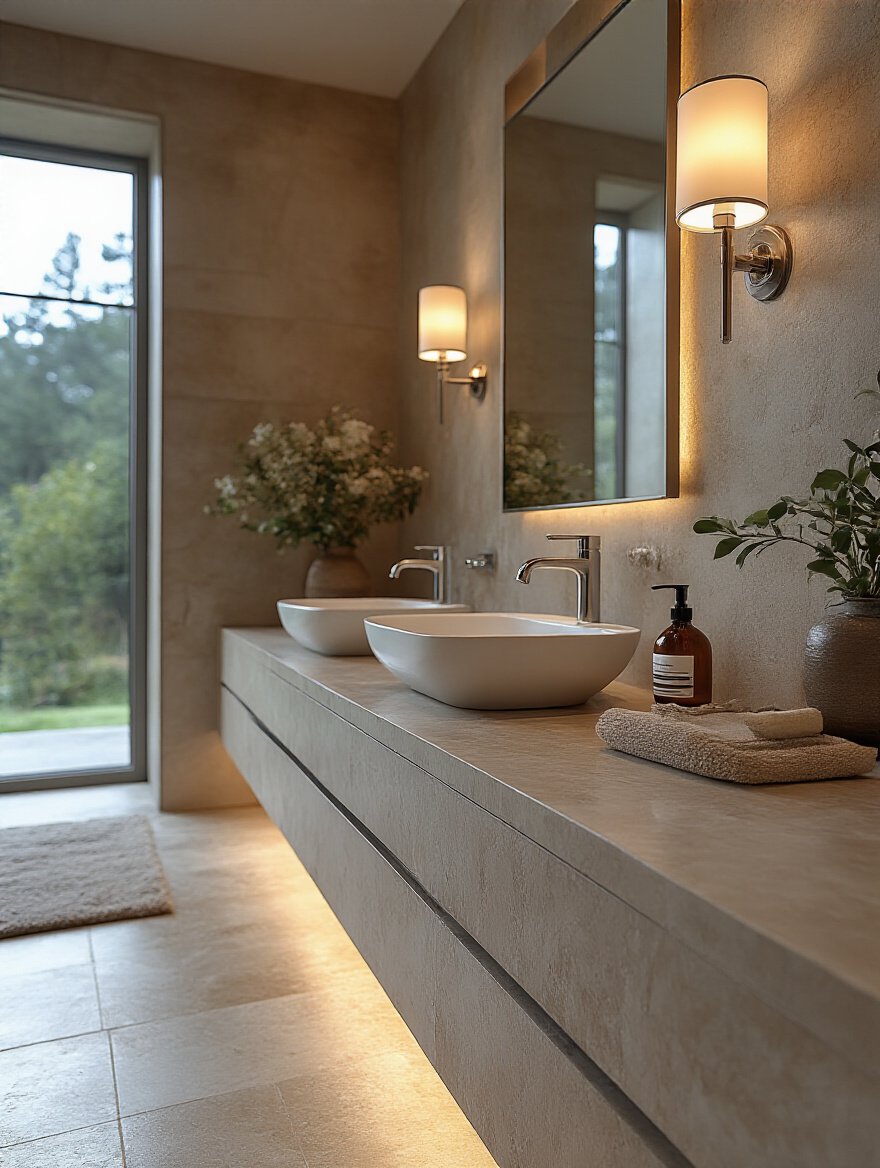
The thing everyone gets wrong, though, is planning. These faucets require the plumbing to be set inside the wall, so it’s a decision you have to make early in the process, not as an afterthought. You also need to invest in quality. I had a client who bought cheap wall-mounted faucets online, and one started leaking inside the wall a year later. It was a nightmare to fix. Go with a reputable brand; it’s not the place to cut corners.
From the sparkle of new faucets, we turn to a small touch that adds a huge amount of comfort.
There is nothing quite like wrapping yourself in a warm towel after a shower. It’s a small, affordable luxury that makes a huge difference in the daily experience. But beyond comfort, it’s also about hygiene, especially in a household with a lot of people sharing a bathroom. A heated rail dries towels much faster, which prevents that musty smell and helps reduce the growth of mold and bacteria.
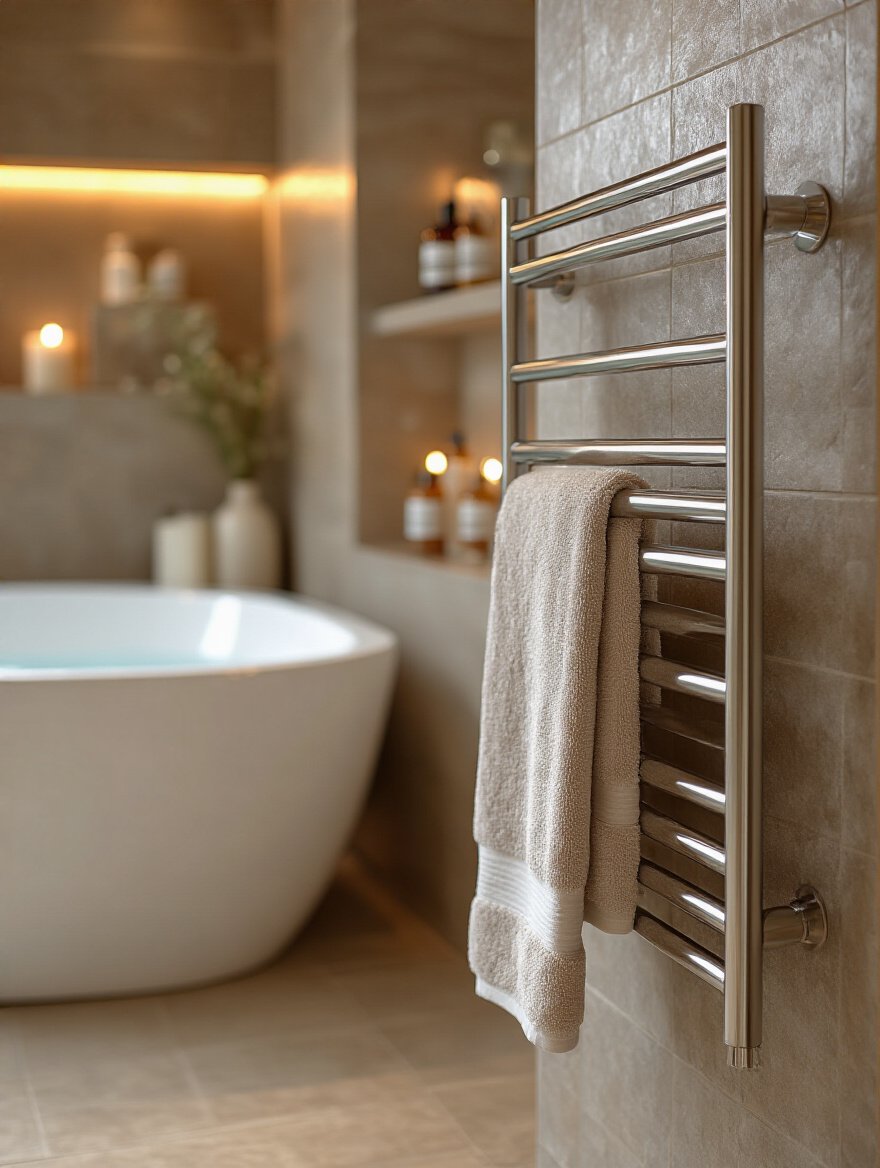
A practical shortcut I love is to get a rail with a timer. You can set it to warm up just before you wake up in the morning, so you get all the comfort without wasting energy all night. For families, I often suggest assigning each person a specific bar on the rail. It’s a simple system that keeps things organized and ensures everyone gets their own warm towel.
Now for a fixture that truly brings together hygiene, comfort, and dignity in a powerful way.
Let’s be direct: smart toilets, and specifically the integrated bidet function, are one of the most important innovations for inclusive, multi-generational design. In many Eastern and European cultures, bidets are standard for hygiene. Integrating this feature is a way of showing respect for cultural norms and making family members from different backgrounds feel comfortable and understood.
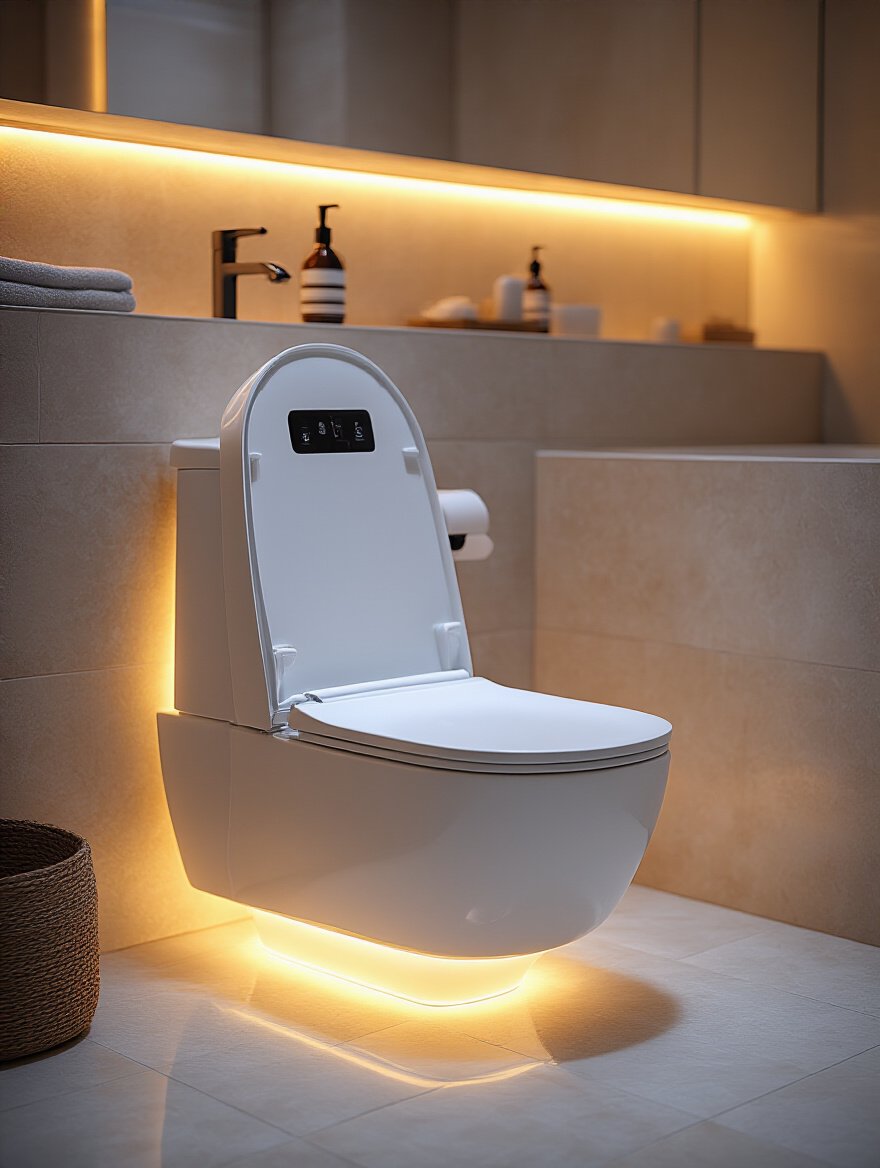
Even more importantly, for aging parents or anyone with mobility limitations, a smart toilet can be the key to maintaining their independence and dignity. Features like a heated seat, a warm water cleanse, an air dryer, and an automatic flush can make personal care so much easier and more private. It’s a deeply thoughtful investment in the long-term well-being and autonomy of your family members. This isn’t about tech for tech’s sake; it’s about care.
Technology in the bathroom shouldn’t be complicated. It should be invisible and intuitive, working in the background to make the space safer, more comfortable, and more personal for everyone.
Don’t get distracted by the fancy models that show you the news while you brush your teeth. That’s just noise. The two features of a smart mirror that actually matter for a family are the integrated, tunable lighting and the defogger. The defogging pad is a lifesaver in a bathroom where people are taking back-to-back showers. No more wiping the mirror with a towel!
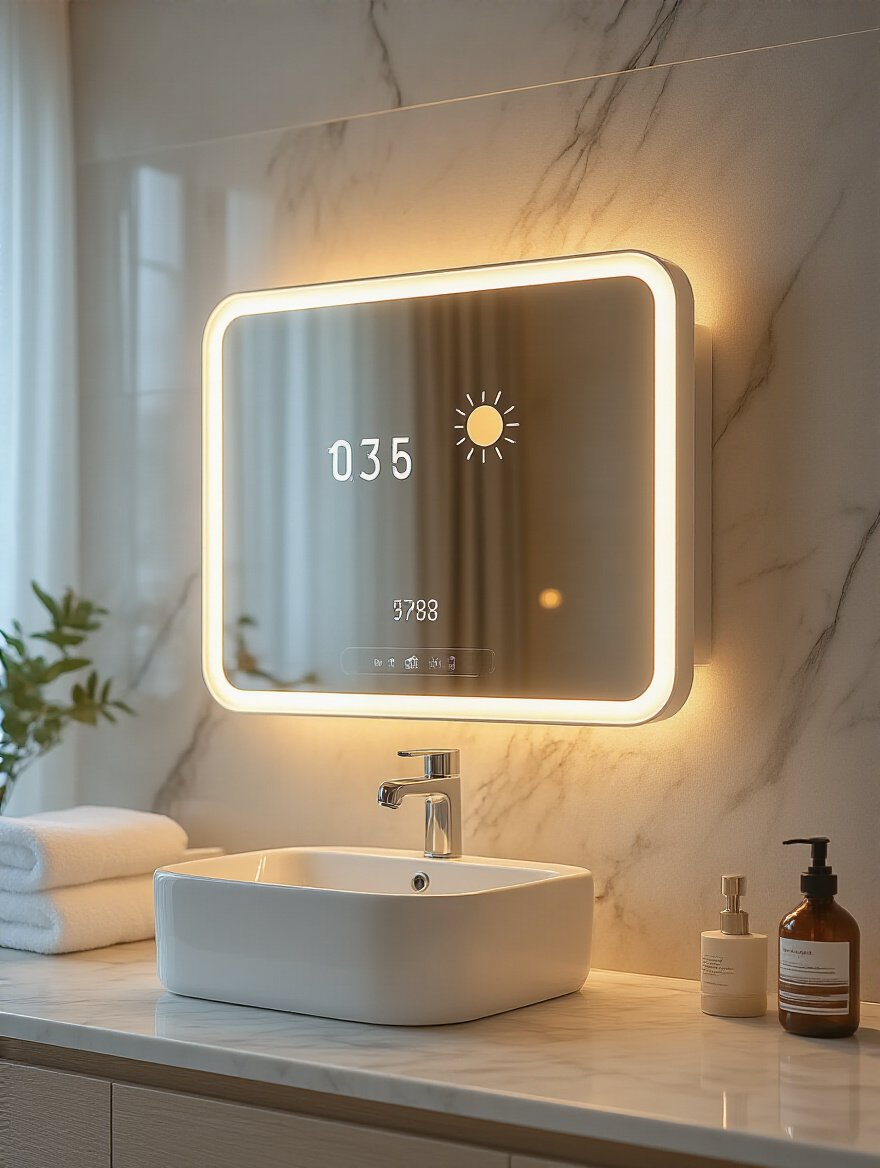
The tunable lighting is even more critical. It allows you to adjust the color and brightness, from a cool, bright light that mimics daylight (perfect for seeing clearly) to a soft, warm glow for the evening. This is a big deal for makeup application, but also for anyone with aging eyes who just needs a bit more light to see properly. It makes the space more functional for everyone at any time of day.
Just like light, sound can completely change the feel of a room, and in a bathroom, it can do more than just entertain.
In a crowded house, the bathroom is often the only place to find a few minutes of peace. An embedded sound system can help create that personal sanctuary. You can play calming music, a podcast, or just some white noise to drown out the household chaos. It’s a way to mentally escape for a moment.
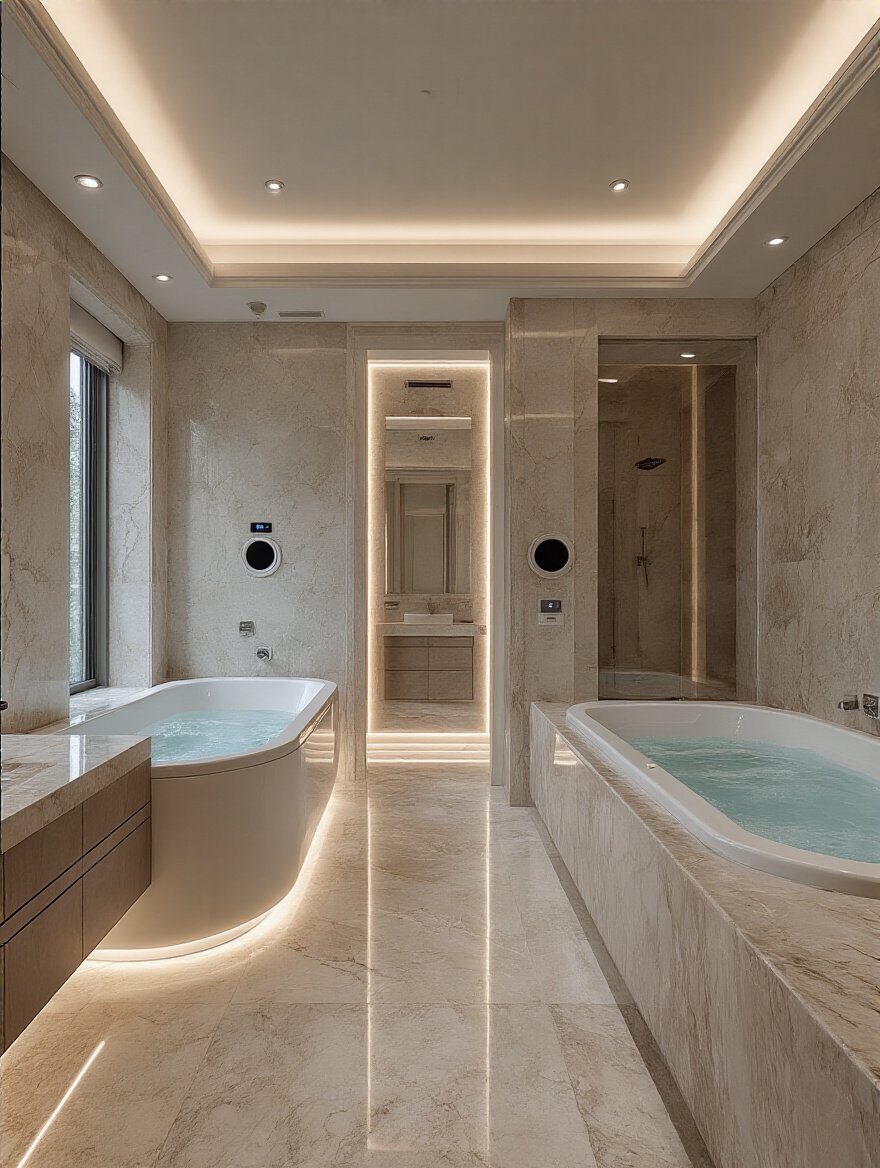
But there’s a practical, and culturally sensitive, aspect to this as well. For many people, a bit of background music provides a welcome sense of auditory privacy in a bathroom, especially when guest or other family members are nearby. I had a client whose house was always full of relatives, and she confessed that the simple act of playing music in the bathroom made her feel much more comfortable. It’s a small detail that helps ease social anxieties.
Now, let’s combine light and sound into something truly dynamic and supportive.
The term “chromotherapy” sounds a bit clinical, but the idea is simple: using light and color to affect your mood. The real power here is in creating pre-programmed “scenes.” This isn’t about turning your shower into a disco. It’s about creating lighting that serves a purpose.
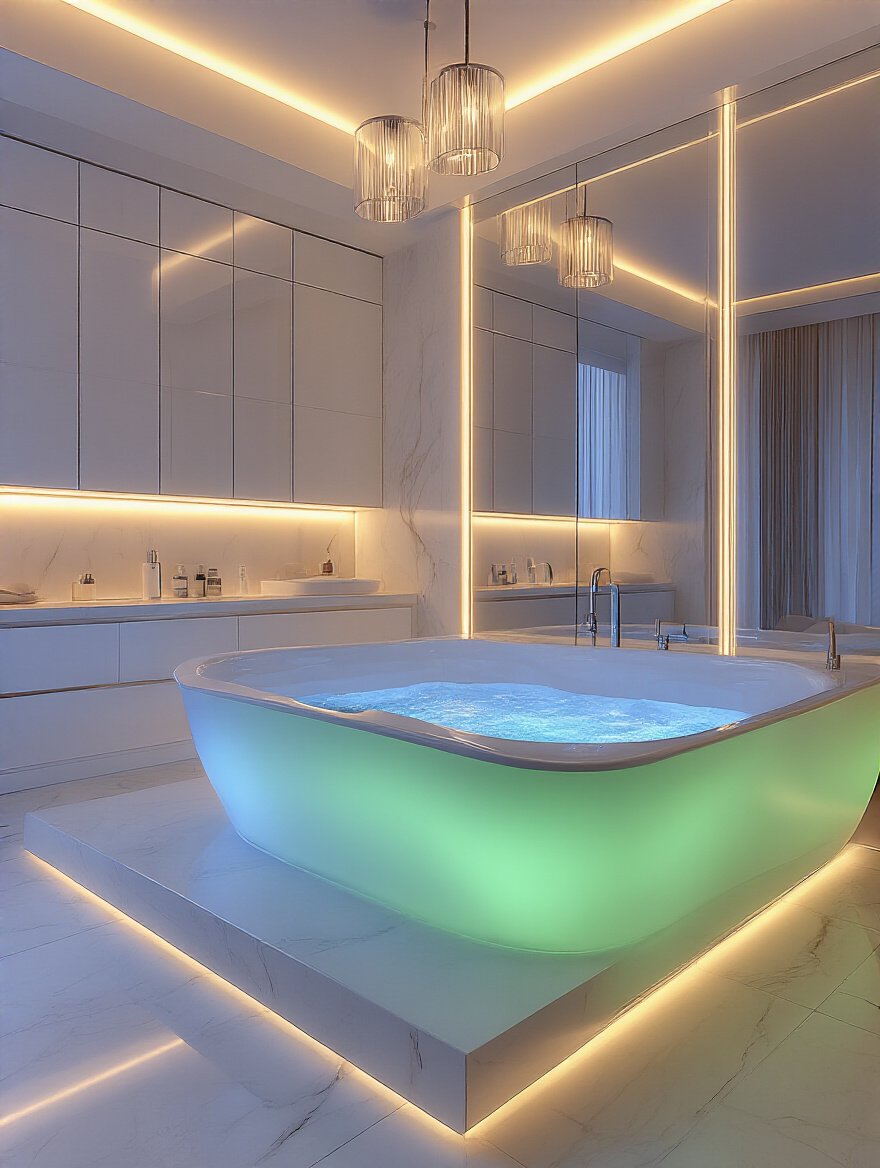
My favorite application is a “Night Path” scene. With one touch, or even a motion sensor, it can turn on dim, low-level lights along the floor and a soft glow at the toilet. This is a game-changing safety feature for children or elderly parents who get up in the middle of the night. No more fumbling for a switch or being blinded by a harsh overhead light. You can also program an “Energize” scene with bright, cool light for the morning and a “Relax” scene with warm, dim light to help you unwind before bed.
To complete the sensory experience, let’s consider the power of scent.
Scent is powerfully tied to memory and emotion, and it plays a huge role in many cultural traditions. Integrating a concealed diffuser—one that’s built into the ventilation system or hidden in cabinetry—is a beautiful way to personalize the atmosphere. You can use calming scents like lavender or chamomile for relaxation, or invigorating scents like eucalyptus or citrus in the morning.

The key is to use it with care, especially in a multi-generational home where people may have sensitivities or allergies. I recommend using high-quality, natural essential oils and keeping the scent very subtle. A wonderful solution is to give each family member their own set of aromatherapy oils that they can add to a small, personal diffuser near their own vanity space. It honors individual preference while keeping the shared air clean and fresh for everyone.
This is the fun part—choosing the materials that you will see and touch every day. The secret here is to choose things that are not only beautiful but also durable, easy to care for, and feel good. The goal is a feast for the senses that is also deeply practical.
Designers love big slabs of stone because they look dramatic and monolithic. But the real reason you should love them is much more practical: fewer grout lines. Grout is a magnet for grime and mold, and it’s a pain to scrub. By using a single, large slab for a shower wall or a countertop, you eliminate 90% of that maintenance. It’s a high-end look that’s actually a low-maintenance choice.
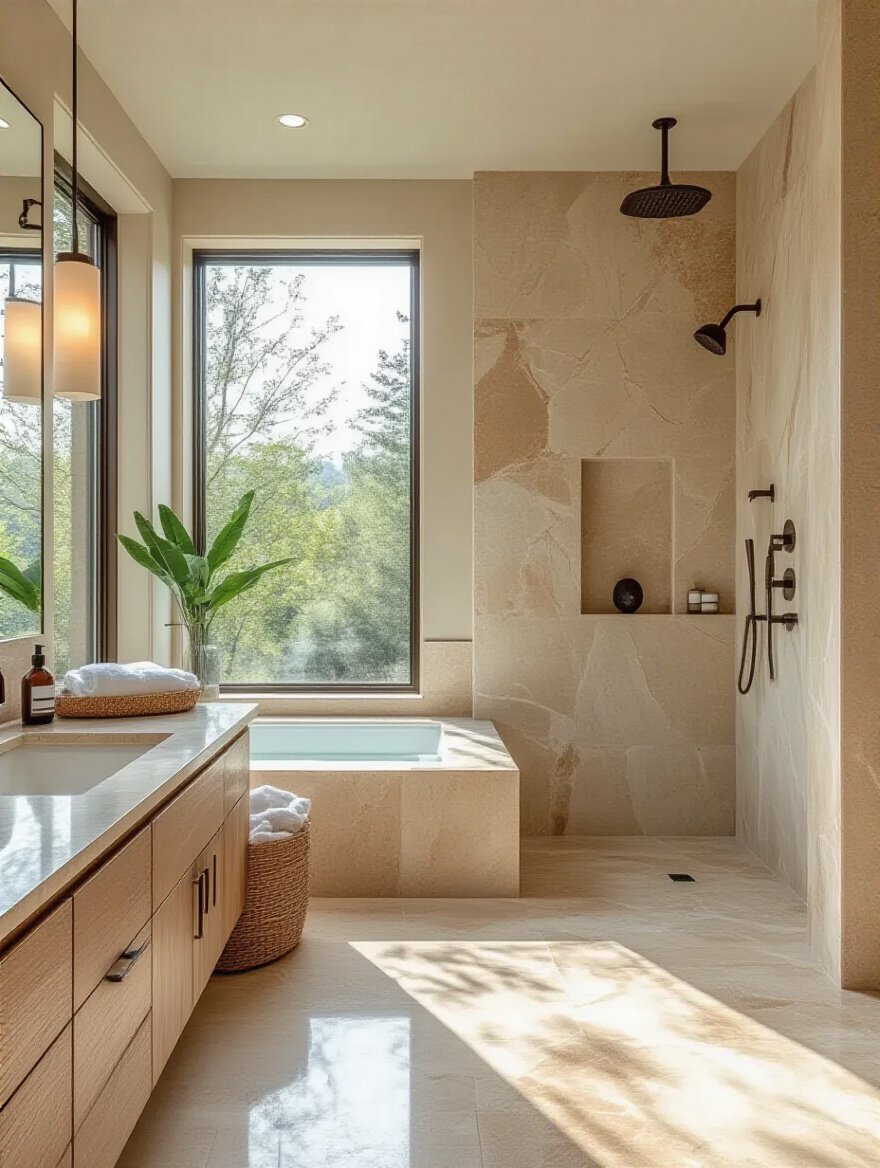
I had a client who was choosing between a huge marble slab and smaller tiles for her shower. The slab was more expensive upfront, but I pointed out how much time and effort she would save on cleaning over the next 20 years. She chose the slab and has never regretted it. Just be sure you work with an installer who specializes in large-format stone—it’s heavy and requires real expertise to handle and install correctly.
To balance the cool elegance of stone, let’s bring in the warmth and character of wood.
So many modern bathrooms end up feeling cold and sterile, like a hospital. Bringing in the warmth and texture of wood is the perfect antidote. Using high-quality wood veneers on vanities or a feature wall can make a bathroom feel like a cozy, restorative sanctuary. It’s a core principle of biophilic design—connecting with natural materials has a proven calming effect.
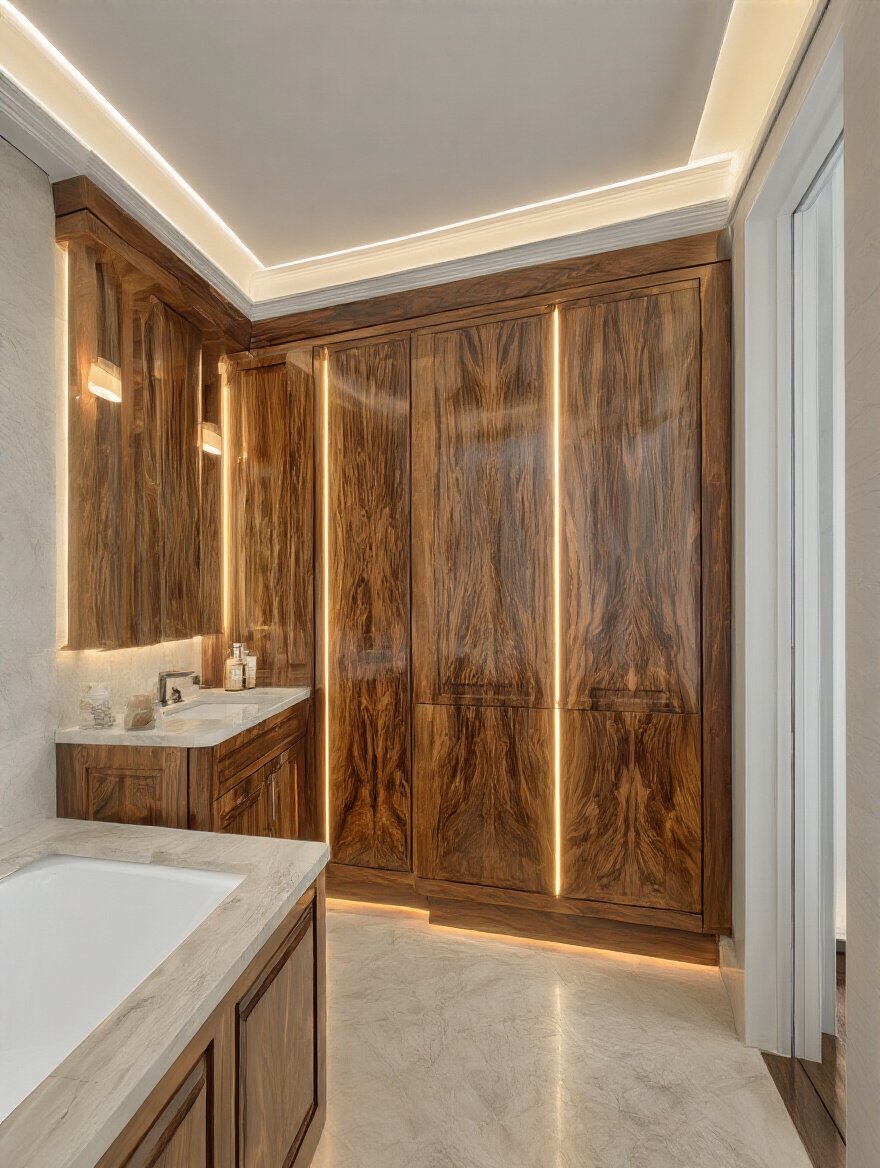
People get scared of wood in a bathroom, but modern veneers, when applied to a moisture-resistant substrate and properly sealed, are incredibly durable and stable. They won’t warp like solid wood can. This is also a place to weave in cultural heritage. For a Japanese family, I used a light, beautiful Hinoki wood veneer. For a family with Scandinavian roots, a pale ash. It’s a subtle nod to identity that makes a space feel deeply personal.
With the backdrop set, let’s add the jewelry of the room—the lighting.
A beautiful chandelier or a modern sculptural pendant can be a stunning focal point, elevating the entire room. It says, “this is a special place.” But here’s the absolute rule you cannot break: it must be on a dimmer. A gorgeous, glittering chandelier that’s blasting at full brightness when you stumble in at 2 AM is not luxury, it’s torture.
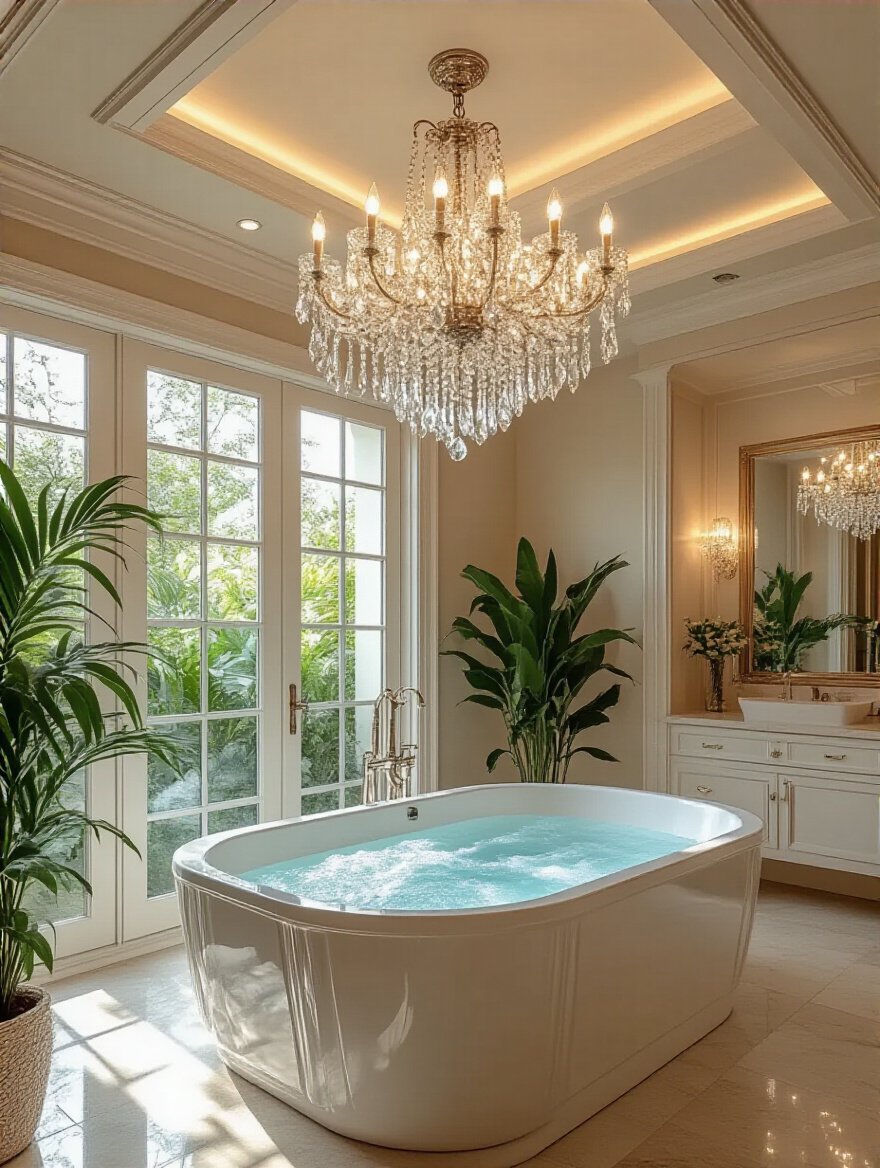
The ability to control the intensity of the light is everything. You want bright light for cleaning, medium light for getting ready, and a very low, soft glow for a relaxing bath. Also, be sure to check the fixture’s IP rating to ensure it’s safe for a damp environment. A lighting specialist can help with this, but it’s a critical safety step that many people overlook.
Now let’s add another layer of visual and tactile interest with unique surface textures.
This is where you can really tell a story and infuse the space with personality and culture. Instead of a flat, boring wall, consider using textured materials. Think of the beautiful, imperfect surface of handmade Moroccan Zellige tiles, the subtle wave of a 3D porcelain tile, or the tactile feel of a plaster finish like Tadelakt. These surfaces catch the light in beautiful ways and invite touch.
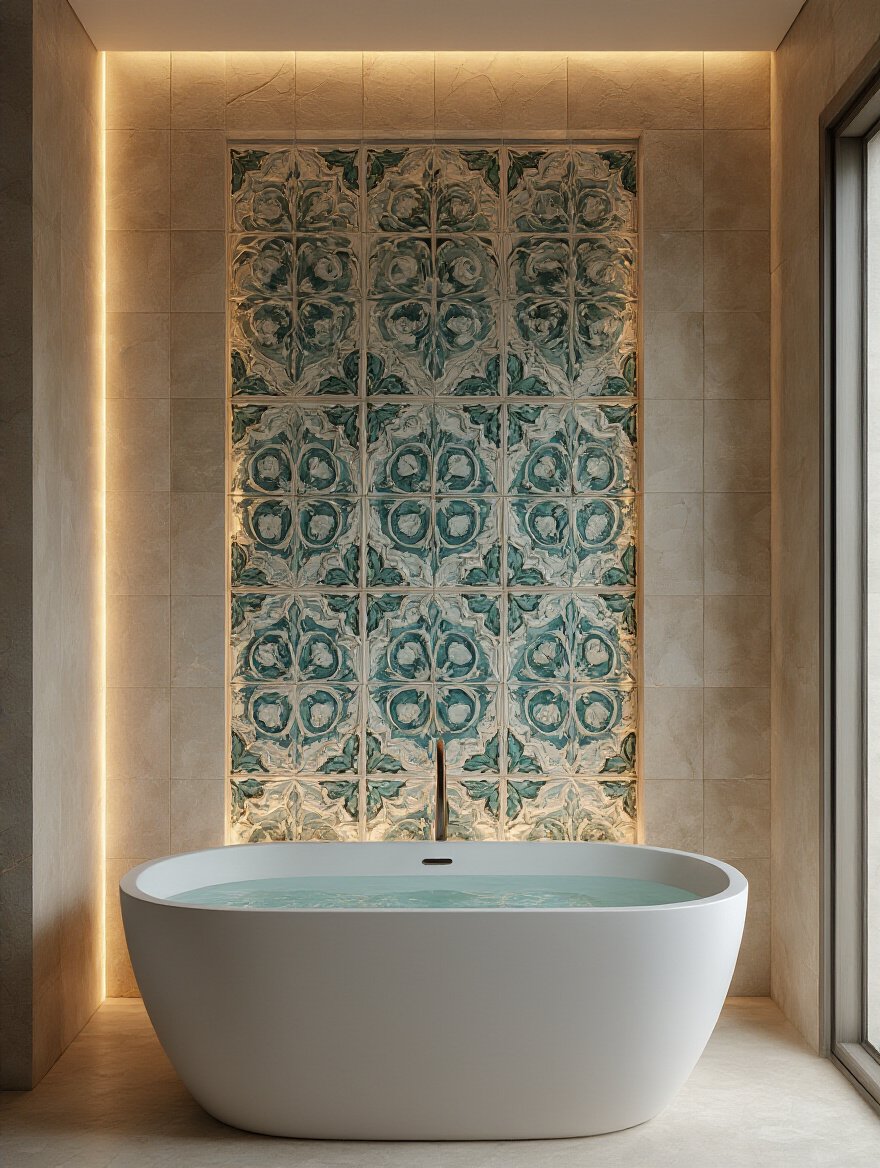
I worked with a family who had spent years living in Mexico, and they missed the vibrant tilework. We found a small company that made beautiful, hand-painted Talavera tiles and used them to create a stunning backsplash behind the vanity. It wasn’t a huge part of the budget, but it was the one thing in the room that was completely, uniquely theirs. It told their story.
From hard surfaces, we move to the soft touches that complete the experience of comfort.
You can have the most expensive bathroom in the world, but if you step out of the shower and grab a thin, scratchy towel, the entire illusion of luxury is shattered. High-quality, plush textiles are one of the most impactful and affordable upgrades you can make. Invest in a set of thick, absorbent bath towels, a soft bath mat that feels good under your feet, and maybe even a beautiful Turkish cotton robe.
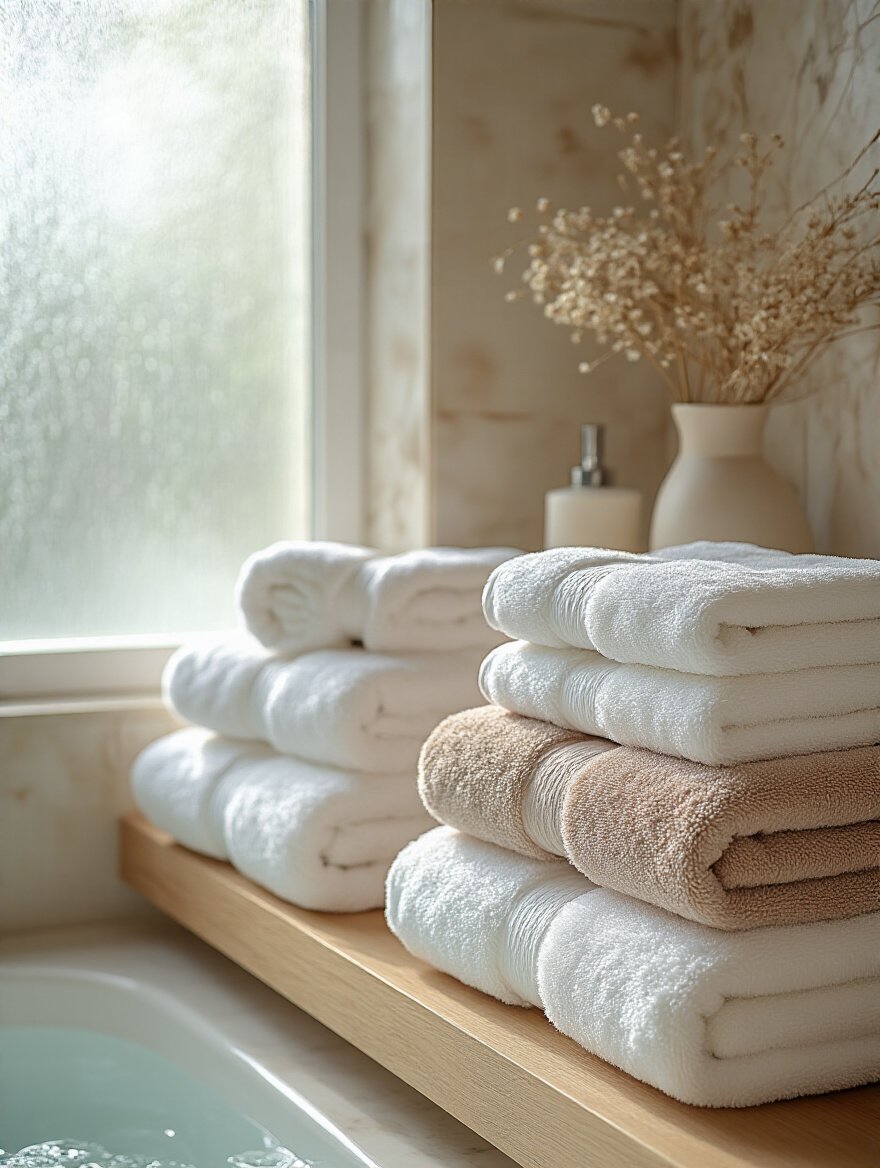
My shortcut for families? Assign a color to each person. It’s a simple organizational trick that cuts down on confusion and “who used my towel?” arguments. It also allows everyone to have the towel style they prefer—maybe your daughter loves an extra-large bath sheet, and your son just wants a standard towel. It’s another small way of respecting individual preferences.
Finally, let’s make sure there’s a place for all these beautiful things to be put away.
Clutter is the enemy of calm. In a family bathroom, bespoke storage isn’t a luxury; it’s a sanity-saver. Custom-designed storage means you use every single inch of space and create a specific home for everything, from the tall shampoo bottles to the electric toothbrushes to the mountain of bath toys.
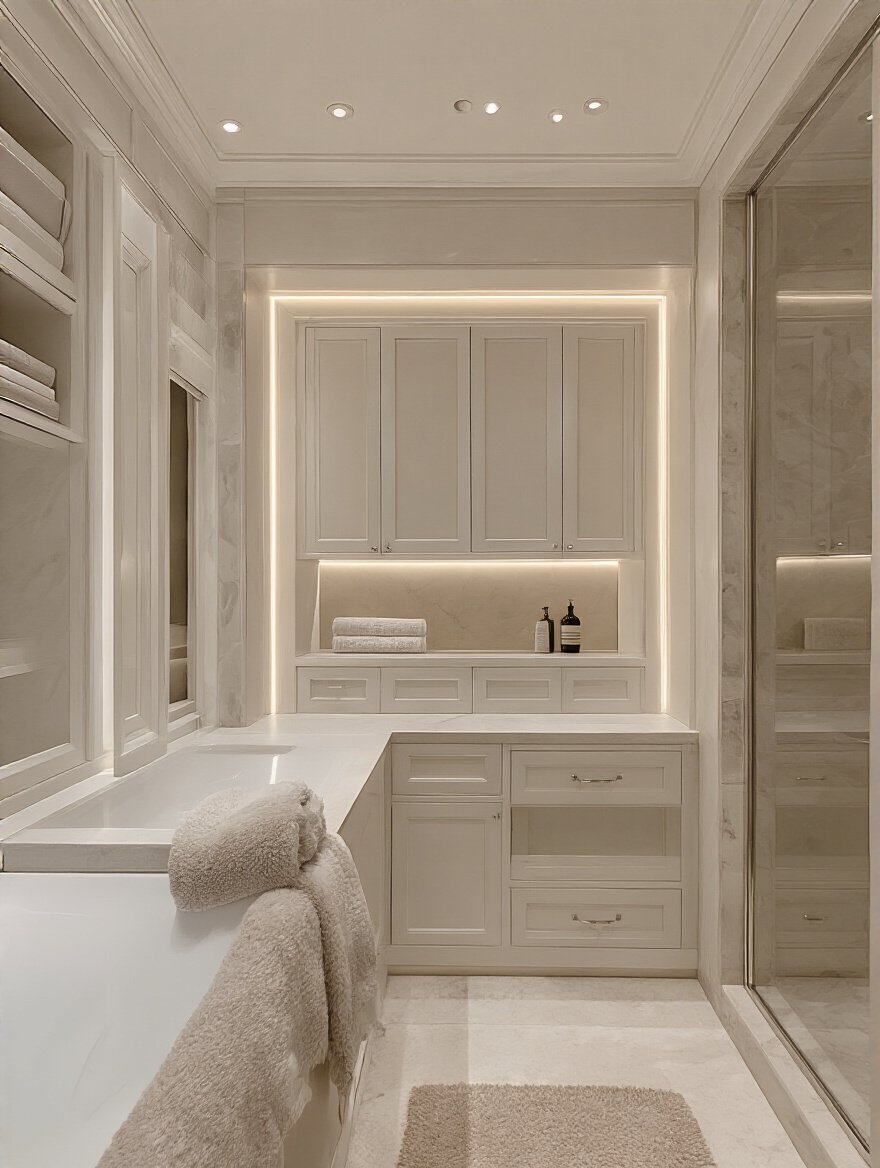
When I design for families, I think about everyone’s needs. This could mean:
I once designed a vanity with deep drawers on one side for a teenager’s large hair products and styling tools, and shallower, divided drawers on the other for her dad’s simple grooming kit. The goal is to make it effortless to put things away, which keeps the room serene and the countertops clear.
If you have the space and budget, you can take your bathroom from a spa-like retreat to a true home wellness center. These features are investments in long-term health and well-being.
These features are about more than just indulgence; they are steeped in cultural traditions and offer proven health benefits. A sauna might be a nod to a family’s Finnish heritage and a place for quiet reflection. A steam room, or hammam, is a central part of social and cleansing rituals in many Middle Eastern and North African cultures. Incorporating one can be a beautiful way to honor family history.
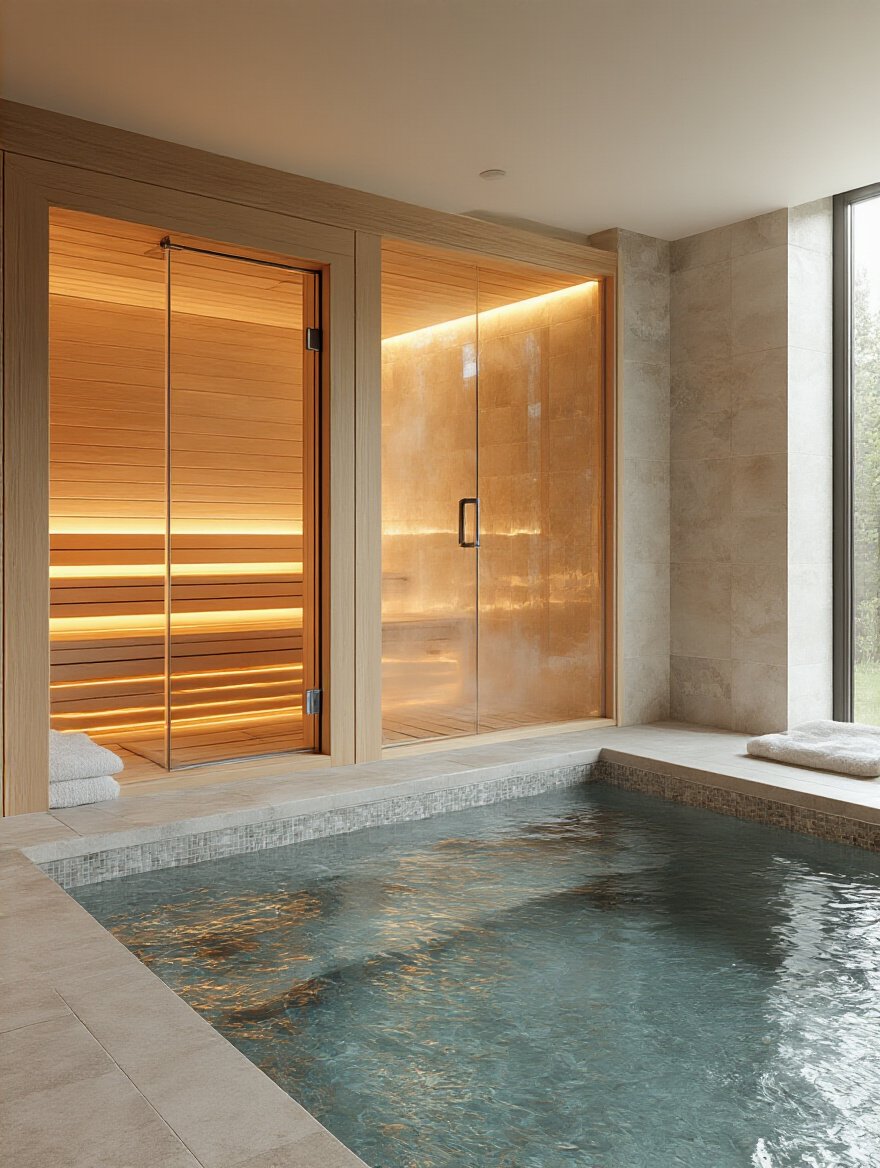
For the modern sandwich-generation family, these become vital tools for self-care. After a stressful day of juggling work, kids, and caring for a parent, a caregiver needs a space to decompress and recover. A 15-minute session in a steam room or sauna can be a powerful ritual for releasing tension and recharging. This isn’t an extravagance; in a high-stress home, it’s a tool for survival and well-being.
In the end, creating a luxury bathroom has very little to do with the latest trends or the most expensive materials. It’s about deep, thoughtful listening. It’s about understanding the unique needs, habits, and cultural backgrounds of every person who will use the space.
True luxury is a bathroom where an aging parent can feel safe and maintain their dignity. It’s a space where a teenager and a parent aren’t fighting over the sink. It’s a sanctuary where a tired caregiver can find a moment of peace. It’s a room that reflects a family’s story and makes everyone, from the youngest to the oldest, feel comfortable, respected, and truly at home. That’s a goal worth investing in.